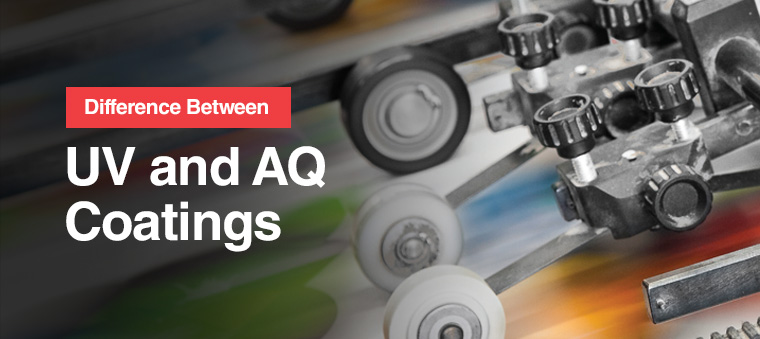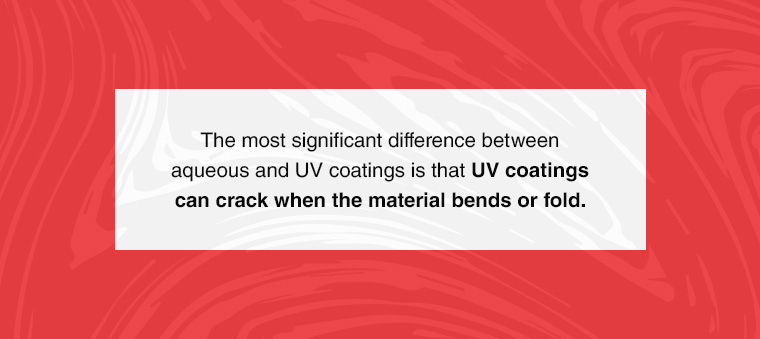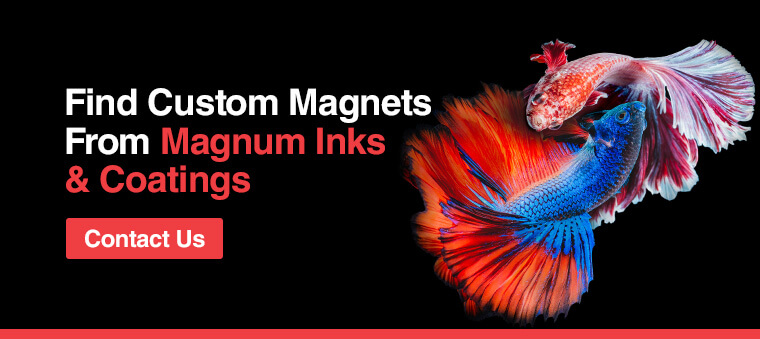
Difference Between UV and AQ Coatings
Coating is a common term in the printing process. This method of protecting printed pieces helps avoid scratches and fingerprints during handling. Additionally, a coating can make pieces look more professional and reduce the production turnaround time, as coatings can seal the ink and enable it to dry nearly instantly.
Two of the most common coatings are UV and aqueous. Both coatings can create more durability for a printed product, but they have some differences. Choosing the right coating can impact your project and ensure your final product is beautiful and professional. Learn about aqueous and UV coating methods to decide which may be more beneficial for your applications.


What Is Aqueous Coating?
Aqueous coating is environmentally friendly. This water-based coating dries quickly when applied to printed materials. This clear coating creates a glossy, satin or soft-touch finish. Several types of aqueous finishes exist, including the following:
- Gloss: If you want your prints to have that beautiful shine, gloss coatings are the way to go.
- Matte: This coating is the opposite of gloss. Rather than creating a shine, matte coatings minimize glossiness to capture more minimalistic and trendy designs.
- Satin: Halfway between gloss and matte, a satin finish can protect your prints from flaws like fingerprints and scuffs that could otherwise distract from your colors and images.
- Soft touch: This type of coating will protect your print while creating a softer and more enjoyable feel.
- Dry erase: Although not as powerful as gloss coating, dry erase coatings offer a better gloss impression than other coatings and make an affordable option for those looking to save on lamination costs.
An aqueous coating is also called a flood finish because it covers the entire printed surface rather than specific areas, which is called spot coating. Spot coating with an aqueous finish is uncommon. However, it can be combined with spot varnish, which creates a highlight over specific areas and maintains a matte finish over the rest of the image. After applying the spot varnish, you cover the entire surface with the aqueous coating. The result is a matte print with glossy spot varnish that draws the eyes and adds depth and light to an image.
This type of coating is often preferable for brochures, flyers and multi-page restaurant menus. The flexibility of this coating helps prevent scratches, scuffs and fingerprints from showing on your images.
What Is UV Coating?
UV coatings can provide a high gloss for printed materials. These coatings offer a reflective sheen that makes colors look more vibrant and deeper. The ink under these coatings dries instantly when exposed to UV radiation. This creates an ideal protective coating for items that experience rough handling. For example, postcards, booklet covers, business cards and presentation folders often experience wear and tear when people travel with them, pack them away or offer them to others.
You can apply this coating over an entire print or use spot coating to create your desired look. Spot coating can be especially beneficial for specific spots on items that experience a lot of wear, as this coating can crack when someone bends or folds the material. Spot coating will empower you to cover the most important details without hindering the look of the rest of the piece.
Aqueous Coating vs. UV Coating
Several factors determine whether a UV coating or aqueous coating will be best for your project. Both coatings are popular in graphic design and offer beautiful aesthetics and durable protection. Additionally, both can protect objects from moisture, grease, heat and alcohol. However, one or the other may be more suitable for your applications.

The most significant difference between aqueous and UV coatings is that UV coatings can crack when the material bends or fold. However, you'll want to consider several other factors before making a final decision for your projects, including the following:
- Budget: Both coating types are typically less expensive than laminate coatings, making them more cost-friendly for those with smaller budgets. However, UV coatings tend to be more costly than aqueous coatings.
- Curing mechanisms: UV and aqueous coatings cure or dry differently. UV coatings use reactive components that cure when exposed to intense ultraviolet light. This process causes liquids to become solid nearly instantly, forming a dry, tough film. Aqueous coatings dry when the volatile components evaporate or a porous substrate absorbs them. This process enables the solids to create a dry, thin film.
- Drying time: Aqueous coatings dry fairly quickly, but you must dedicate time to the clean-up process between press stoppage. However, UV coatings do not need this attention, as these prints can stay open on the press when UV light is absent. The additional time you need to dedicate to aqueous coatings can create downtimes and waste in production.
- Application equipment: You can use screen processes or press-end coaters to apply UV or aqueous coatings. However, aqueous coatings require special drying equipment with hot air knives, infrared emitters and air extraction devices for some processes.
- Resistance: UV coatings often offer better resistance to chemicals, blocking, marring and abrasion. Aqueous coatings will still provide good block, mar and rub resistance, but you may want to consider additional coating products to protect your materials from moisture, alkalis, alcohol and grease.
- Environmental influences: Aqueous coatings are non-toxic, offering clean air, non-flammability, zero alcohol and non-polluting properties. Although cured UV coatings can provide similar effects, wet coatings contain reactive components that can possess a sharp odor and irritants. Additionally, dried aqueous and cured UV coatings are recyclable, but UV coatings are slower to biodegrade. Due to these potential impacts, aqueous coatings are better if you need to meet FDA requirements, while only some UV coatings conform to the same regulations.
Find Custom Magnets From Magnum Inks & Coatings

Finding the right coating for your projects is essential. The right coating can enhance customers' experiences while protecting materials from wear and tear.
At Magnum Inks & Coatings, we offer an array of ink and coating products, including aqueous and UV coatings. With us, you can find:
Browse our selection to find products to suit your needs, or contact us for custom requests.